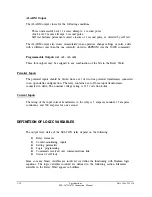
Specifically, the triggering events are:
(1)
(2)
(3)
(4)
RELAY ELEMENTS (high-level trigger)
Ground overcurrent Zones 1, 2, or 3 (67N1, 67N2, 67N3)
Phase overcurrent Zones 1, 2, or 3 (67P1, 67P2, 67P3)
Ground time-overcurrent 51N pickup
Phase time-overcurrent 51P pickup
CONTACT INPUTS (rising edge trigger)
External Trigger
Direct Trip
Permissive Trip
Block Trip
CONTACT OUTPUTS (rising edge trigger)
TRIP
USER ENTERED COMMANDS (rising edge trigger)
TRIGGER
OPEN
Note that the fault locator is triggered by the relay elements in a level sensitive manner. That
is, additional event reports are not generated when additional relay elements pick up. Only
the first relay element of any contiguous sequence triggers an event report.
Furthermore, all triggering relay elements must drop out for at least four cycles before they
may initiate another event report. (This helps eliminate triggering multiple records for
boundary faults.)
All other triggering events are rising-edge sensitive, meaning that for these events, additional
reports are generated even while any or all relay elements remain picked up. This strategy
permits, for example, the recording of fault clearing even when it occurs long after the initial
event report is completed.
The fault location is always determined for event records in which any triggering relay
elements are picked up, providing they are not picked up in the first seven rows of prefault
data, or only in the last five rows of the event report. Furthermore, whenever the locator is
able to determine the fault location, the corresponding record is labeled according to fault
type, regardless of what actually triggered the event report. On the other hand, event records
taken when no triggering relay elements are picked up are labeled as follows:
or
"
EXT
"
for reports triggered externally via input
contacts or by the
"
TRIGGER
"
command
"
TRIP
"
for reports triggered by the assertion of the
"
TRIP
"
output contact.
The actual fault location algorithm is composed of two steps. First the fault type must be
determined, and then the location calculated.
2-22
Specifications
SEL-267D/167D Instruction Manual
Date Code 920326
Summary of Contents for SEL-167D
Page 3: ......
Page 6: ......
Page 8: ......
Page 9: ......
Page 10: ......
Page 11: ......
Page 51: ...LOGIC DIAGRAMS Date Code 920326 Specifications SEL 267D 167D Instruction Manual 2 31 ...
Page 52: ...Date Code 920326 Specifications 2 32 SEL 267D 167D Instruction Manual ...
Page 53: ...Date Code 920326 Specifications SEL 267D 167D Instruction Manual 2 33 ...
Page 54: ...Date Code 920326 Specifications SEL 267D 167D Instruction Manual 2 34 ...
Page 88: ...SAMPLE EVENT REPORT ...
Page 114: ......
Page 115: ......






























